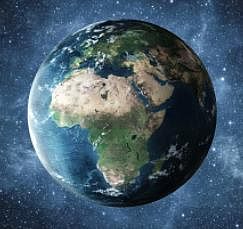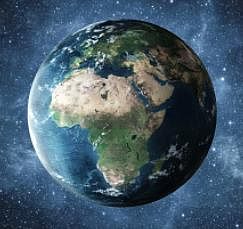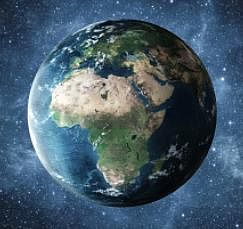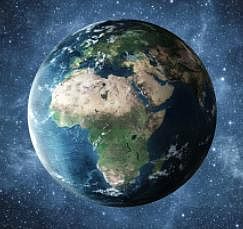Case Based Questions Test: Gravitation - NEET MCQ
10 Questions MCQ Test Topic-wise MCQ Tests for NEET - Case Based Questions Test: Gravitation
Journey through the center of earth:
Suppose you could dig a tunnel from one surface to the opposite through the centre of the Earth. How will the journey be through the tunnel? Let us assume that the Earth to be of uniform density, there is no air friction and temperature is normal. At the starting point the initial acceleration will be g = 9.8 m/s2.

The acceleration gradually reduces as one approaches the center.

The gravity at any radius reff is less than REarth and is linearly proportional to the distance from the center. So, the weight will goes on reducing as the centre is approached. It will again goes on increasing as one moves from away from the centre. The traveller will pop up on the opposite side of the Earth within 42 minutes approximately. But unless the traveller grabs something to hold on, he or she will fall back for a return journey and continue to oscillate with a round-trip time. The time period will be

Compare the weight of the traveller at point A and B inside the tunnel.
Suppose you could dig a tunnel from one surface to the opposite through the centre of the Earth. How will the journey be through the tunnel? Let us assume that the Earth to be of uniform density, there is no air friction and temperature is normal. At the starting point the initial acceleration will be g = 9.8 m/s2.



Journey through the center of earth:
Suppose you could dig a tunnel from one surface to the opposite through the centre of the Earth. How will the journey be through the tunnel? Let us assume that the Earth to be of uniform density, there is no air friction and temperature is normal. At the starting point the initial acceleration will be g = 9.8 m/s2.

The acceleration gradually reduces as one approaches the center.

The gravity at any radius reff is less than REarth and is linearly proportional to the distance from the center. So, the weight will goes on reducing as the centre is approached. It will again goes on increasing as one moves from away from the centre. The traveller will pop up on the opposite side of the Earth within 42 minutes approximately. But unless the traveller grabs something to hold on, he or she will fall back for a return journey and continue to oscillate with a round-trip time. The time period will be

How the acceleration due to gravity varies inside the tunnel?
Suppose you could dig a tunnel from one surface to the opposite through the centre of the Earth. How will the journey be through the tunnel? Let us assume that the Earth to be of uniform density, there is no air friction and temperature is normal. At the starting point the initial acceleration will be g = 9.8 m/s2.



| 1 Crore+ students have signed up on EduRev. Have you? Download the App |
Journey through the center of earth:
Suppose you could dig a tunnel from one surface to the opposite through the centre of the Earth. How will the journey be through the tunnel? Let us assume that the Earth to be of uniform density, there is no air friction and temperature is normal. At the starting point the initial acceleration will be g = 9.8 m/s2.

The acceleration gradually reduces as one approaches the center.

The gravity at any radius reff is less than REarth and is linearly proportional to the distance from the center. So, the weight will goes on reducing as the centre is approached. It will again goes on increasing as one moves from away from the centre. The traveller will pop up on the opposite side of the Earth within 42 minutes approximately. But unless the traveller grabs something to hold on, he or she will fall back for a return journey and continue to oscillate with a round-trip time. The time period will be

Which parameter of the traveller will be non-zero at the centre of the earth during this journey?
Suppose you could dig a tunnel from one surface to the opposite through the centre of the Earth. How will the journey be through the tunnel? Let us assume that the Earth to be of uniform density, there is no air friction and temperature is normal. At the starting point the initial acceleration will be g = 9.8 m/s2.



Journey through the center of earth:
Suppose you could dig a tunnel from one surface to the opposite through the centre of the Earth. How will the journey be through the tunnel? Let us assume that the Earth to be of uniform density, there is no air friction and temperature is normal. At the starting point the initial acceleration will be g = 9.8 m/s2.

The acceleration gradually reduces as one approaches the center.

The gravity at any radius reff is less than REarth and is linearly proportional to the distance from the center. So, the weight will goes on reducing as the centre is approached. It will again goes on increasing as one moves from away from the centre. The traveller will pop up on the opposite side of the Earth within 42 minutes approximately. But unless the traveller grabs something to hold on, he or she will fall back for a return journey and continue to oscillate with a round-trip time. The time period will be

The approximate time required for the journey from A to D and back to A through the tunnel is
Journey through the center of earth:
Suppose you could dig a tunnel from one surface to the opposite through the centre of the Earth. How will the journey be through the tunnel? Let us assume that the Earth to be of uniform density, there is no air friction and temperature is normal. At the starting point the initial acceleration will be g = 9.8 m/s2.

The acceleration gradually reduces as one approaches the center.

The gravity at any radius reff is less than REarth and is linearly proportional to the distance from the center. So, the weight will goes on reducing as the centre is approached. It will again goes on increasing as one moves from away from the centre. The traveller will pop up on the opposite side of the Earth within 42 minutes approximately. But unless the traveller grabs something to hold on, he or she will fall back for a return journey and continue to oscillate with a round-trip time. The time period will be

What may happen if the traveller reaching point D does not grab something to hold on?
Black hole:
A black hole is a place in space where gravity pulls so much that even light can not get out. The gravity is so strong because matter has been squeezed into a tiny space. From Newton’s universal law of gravitation,
![]()
The photons have no mass. From Einstein’s mass energy equivalence relation E = mc2 According to quantum theory of radiation, E = hv
∴ m = h/cλ
Putting in the expression of Newton’s law of gravitation, Force acting on the light particles
![]()
Because no light can get out, people can't see black holes. They are invisible. Space telescopes with special tools can help find black holes. A beam of light just grazing the edge of the sun also bend a little. This may be observed during total solar eclipse. The position of a star will appears closer to the sun. Black holes can be big or small. Scientists think the smallest black holes are as small as just one atom. These black holes are very tiny but have the extremely high density. Another kind of black hole is called "stellar." Its mass can be up to 20 times more than the mass of the sun. There may be many, many stellar mass black holes in milky Way. The largest black holes are called "super massive." These black holes have masses those are more than 1 million suns together. Scientists have found proof that every large galaxy contains a super massive black hole at its center. The super massive black hole at the center of the Milky Way galaxy is called Sagittarius A. It has a mass equal to about 4 million suns and would fit inside a very large ball that could hold a few million Earths. A black hole can not be seen because strong gravity pulls all of the light into the middle of the black hole. But scientists can see how the strong gravity affects the stars and gas around the black hole. If a black hole the same mass as the sun replace the sun, Earth and the other planets will orbit the black hole as they orbit the sun now.
The gravity of black hole is so strong because
Black hole:
A black hole is a place in space where gravity pulls so much that even light can not get out. The gravity is so strong because matter has been squeezed into a tiny space. From Newton’s universal law of gravitation,
![]()
The photons have no mass. From Einstein’s mass energy equivalence relation E = mc2 According to quantum theory of radiation, E = hv
∴ m = h/cλ
Putting in the expression of Newton’s law of gravitation, Force acting on the light particles
![]()
Because no light can get out, people can't see black holes. They are invisible. Space telescopes with special tools can help find black holes. A beam of light just grazing the edge of the sun also bend a little. This may be observed during total solar eclipse. The position of a star will appears closer to the sun. Black holes can be big or small. Scientists think the smallest black holes are as small as just one atom. These black holes are very tiny but have the extremely high density. Another kind of black hole is called "stellar." Its mass can be up to 20 times more than the mass of the sun. There may be many, many stellar mass black holes in milky Way. The largest black holes are called "super massive." These black holes have masses those are more than 1 million suns together. Scientists have found proof that every large galaxy contains a super massive black hole at its center. The super massive black hole at the center of the Milky Way galaxy is called Sagittarius A. It has a mass equal to about 4 million suns and would fit inside a very large ball that could hold a few million Earths. A black hole can not be seen because strong gravity pulls all of the light into the middle of the black hole. But scientists can see how the strong gravity affects the stars and gas around the black hole. If a black hole the same mass as the sun replace the sun, Earth and the other planets will orbit the black hole as they orbit the sun now.
What will happen to the earth and other planets if a black hole of same mass as the sun replaces the sun?
Black hole:
A black hole is a place in space where gravity pulls so much that even light can not get out. The gravity is so strong because matter has been squeezed into a tiny space. From Newton’s universal law of gravitation,
![]()
The photons have no mass. From Einstein’s mass energy equivalence relation E = mc2 According to quantum theory of radiation, E = hv
∴ m = h/cλ
Putting in the expression of Newton’s law of gravitation, Force acting on the light particles
![]()
Because no light can get out, people can't see black holes. They are invisible. Space telescopes with special tools can help find black holes. A beam of light just grazing the edge of the sun also bend a little. This may be observed during total solar eclipse. The position of a star will appears closer to the sun. Black holes can be big or small. Scientists think the smallest black holes are as small as just one atom. These black holes are very tiny but have the extremely high density. Another kind of black hole is called "stellar." Its mass can be up to 20 times more than the mass of the sun. There may be many, many stellar mass black holes in milky Way. The largest black holes are called "super massive." These black holes have masses those are more than 1 million suns together. Scientists have found proof that every large galaxy contains a super massive black hole at its center. The super massive black hole at the center of the Milky Way galaxy is called Sagittarius A. It has a mass equal to about 4 million suns and would fit inside a very large ball that could hold a few million Earths. A black hole can not be seen because strong gravity pulls all of the light into the middle of the black hole. But scientists can see how the strong gravity affects the stars and gas around the black hole. If a black hole the same mass as the sun replace the sun, Earth and the other planets will orbit the black hole as they orbit the sun now.
A beam of light just grazing the edge of the sun also bend a little. It is observable during
Black hole:
A black hole is a place in space where gravity pulls so much that even light can not get out. The gravity is so strong because matter has been squeezed into a tiny space. From Newton’s universal law of gravitation,
![]()
The photons have no mass. From Einstein’s mass energy equivalence relation E = mc2 According to quantum theory of radiation, E = hv
∴ m = h/cλ
Putting in the expression of Newton’s law of gravitation, Force acting on the light particles
![]()
Because no light can get out, people can't see black holes. They are invisible. Space telescopes with special tools can help find black holes. A beam of light just grazing the edge of the sun also bend a little. This may be observed during total solar eclipse. The position of a star will appears closer to the sun. Black holes can be big or small. Scientists think the smallest black holes are as small as just one atom. These black holes are very tiny but have the extremely high density. Another kind of black hole is called "stellar." Its mass can be up to 20 times more than the mass of the sun. There may be many, many stellar mass black holes in milky Way. The largest black holes are called "super massive." These black holes have masses those are more than 1 million suns together. Scientists have found proof that every large galaxy contains a super massive black hole at its center. The super massive black hole at the center of the Milky Way galaxy is called Sagittarius A. It has a mass equal to about 4 million suns and would fit inside a very large ball that could hold a few million Earths. A black hole can not be seen because strong gravity pulls all of the light into the middle of the black hole. But scientists can see how the strong gravity affects the stars and gas around the black hole. If a black hole the same mass as the sun replace the sun, Earth and the other planets will orbit the black hole as they orbit the sun now.
The super massive black hole at the center of the Milky Way galaxy is
Black hole:
A black hole is a place in space where gravity pulls so much that even light can not get out. The gravity is so strong because matter has been squeezed into a tiny space. From Newton’s universal law of gravitation,
![]()
The photons have no mass. From Einstein’s mass energy equivalence relation E = mc2 According to quantum theory of radiation, E = hv
∴ m = h/cλ
Putting in the expression of Newton’s law of gravitation, Force acting on the light particles
![]()
Because no light can get out, people can't see black holes. They are invisible. Space telescopes with special tools can help find black holes. A beam of light just grazing the edge of the sun also bend a little. This may be observed during total solar eclipse. The position of a star will appears closer to the sun. Black holes can be big or small. Scientists think the smallest black holes are as small as just one atom. These black holes are very tiny but have the extremely high density. Another kind of black hole is called "stellar." Its mass can be up to 20 times more than the mass of the sun. There may be many, many stellar mass black holes in milky Way. The largest black holes are called "super massive." These black holes have masses those are more than 1 million suns together. Scientists have found proof that every large galaxy contains a super massive black hole at its center. The super massive black hole at the center of the Milky Way galaxy is called Sagittarius A. It has a mass equal to about 4 million suns and would fit inside a very large ball that could hold a few million Earths. A black hole can not be seen because strong gravity pulls all of the light into the middle of the black hole. But scientists can see how the strong gravity affects the stars and gas around the black hole. If a black hole the same mass as the sun replace the sun, Earth and the other planets will orbit the black hole as they orbit the sun now.
The attractive force acting on a light particle by a black hole is
|
9 docs|1272 tests
|






















